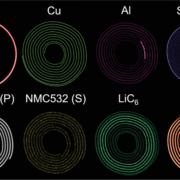Latest work on diffraction tomography of a commercially-available cylindrical NMC liion battery
Synchrotron high-energy X-ray diffraction computed tomography has been employed to investigate, for the first time, commercial cylindrical Li-ion batteries electrochemically cycled over the two cycling rates of C/2 and C/20. This technique yields maps of the crystalline components and chemical species as a cross-section of the cell with high spatiotemporal resolution (550 × 550 images with 20 × 20 × 3 µm3 voxel size in ca. 1 h). The recently developed Direct Least-Squares Reconstruction algorithm is used to overcome the well-known parallax problem and led to accurate lattice parameter maps for the device cathode. Chemical heterogeneities are revealed at both electrodes and are attributed to uneven Li and current distributions in the cells. It is shown that this technique has the potential to become an invaluable diagnostic tool for real-world commercial batteries and for their characterization under operating conditions, leading to unique insights into “real” battery degradation mechanisms as they occur.
Read the full paper at https://doi.org/10.1002/smtd.202100512

